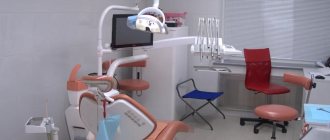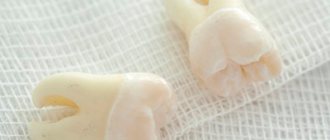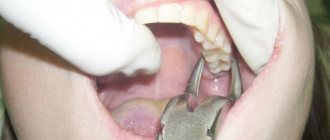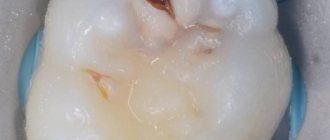Often, removal of the dental nerve, or pulp, is a necessary measure in the treatment of advanced dental pathologies. The procedure is quite complex, so it should only be performed by a qualified dentist with extensive practical experience.
To avoid medical errors and complications, contact the Mitino Dental Center. Our doctors know how to painlessly remove the nerve of a tooth and prevent its premature destruction.
Why is it necessary to remove a nerve?
Removal of the dental nerve is required in advanced inflammatory processes that affect both soft and hard tissue structures, including the pulp.
The most common reasons:
- periodontitis,
- pulpitis,
- benign neoplasm near the root,
- deep pulpal caries.
Depending on the type of pathological process and the size of the affected area, removal is carried out with partial preservation of the pulp or complete preservation from all canals. Amputation of part of the nerve is usually used for dental caries. In other cases, complete removal is usually necessary.
Toothache is one of the most unpleasant sensations a person knows. The tooth has a complex structure. Inside there are nerve endings and blood vessels, which together form the so-called pulp area. Thanks to this, we feel warm or cold. At the same time, it protects against the proliferation of harmful bacteria and provides nutrition to the tooth. Therefore, it is important to keep the pulp alive. But, if this is not possible, an operation is required to remove the pulp tissue, or in other words, removal of the nerve.
Modern methods used by Elena Plus dentists cause minimal discomfort. The clinic’s experienced doctors will prescribe effective individual treatment and restore the functionality of the tooth.
To delete or not to delete – that is the question
From the point of view of specialists, depulpation should be resorted to in extreme cases, trying to use less radical methods. In cases of pulpitis with extensive lesions, periodontitis, serious caries (large “hollow”), mechanical damage, orthopedic indications (prosthetics), it is often impossible to avoid surgery, so it is necessary to remove and clean the canals.
Unfortunately, the doctor does not have the opportunity to look inside the inflamed area and determine whether the pathological process is reversible. What will help? Only the doctor’s experience and attention to characteristic complaints of pain.
Depulpation is inevitable if:
- A person experiences a nagging, rather severe pain that appears unexpectedly and lasts a long time. When bending over or trying to lie down, the pain intensifies, as well as at night. Do not suppress them with analgin, this is a temporary measure and does not always help, urgently call the reception desk of the Elena Plus clinic.
- Discomfort occurs as a reaction to contact with cold or hot and continues for some time after the irritant is removed. A second, fleeting sensation of pain is a sign that not all is lost. However, pain when brushing teeth or biting is not a pulp problem.
Diagnosis is complicated by the fact that sensations are sometimes transferred to the other jaw, and this is typical for eights (wisdom teeth).
An X-ray will also not help determine the degree of reversibility or advanced stage of the problem, since inflammation of the soft tissue is not reflected in the image. Electrodontometry data are quite relative.
However, having collected all possible information, the doctor makes a “sentence” - it cannot be treated, it must be removed. If there are no contraindications, such as acute infection, stomatitis, open tuberculosis or viral hepatitis, a decision is made to completely or partially remove the pulp.
How to remove pulp
In dentistry, two methods of performing the operation are used:
- With the help of arsenic. The classic method is often very painful and time-consuming.
- With the use of anesthesia. Its advantages: no pain, comfort and speed.
Classic method
When choosing the first method, which has been around for decades, it is not arsenic that is actually used, but a special deadening paste based on arsenous anhydride, which makes up about one-third of the composition. The recipe contains painkillers, an antiseptic with an astringent and a filler. The paste is formed into a 10 mg ball and placed into the canals, previously expanded with a drill. After which it is closed with a temporary filling for 1-3 days.
The necrotizing agent gradually deadens the nerve. After the due date, the canals are opened, the dead nerve is removed, cleaned and a permanent filling is placed. You should be extremely careful and do not miss the deadline for removing the paste, so as not to destroy the dental tissues.
Despite its solid track record, this method is rarely used in modern therapy. At the Elena Plus clinic, preference is given to a more humane and effective method.
Treatment in one session
The use of anesthesia saves the patient’s time, the operation itself does not cause discomfort and is performed in one visit to the doctor, the risk of complications is minimized.
After performing an anesthetic injection, the dentist gains access to the nerve and removes it using specialized instruments without causing the slightest discomfort. The entire procedure takes up to thirty minutes. The instruments allow you to determine the length of the canal, ensure complete tissue removal, and thoroughly clean the canals, constantly monitoring the process. To be on the safe side, a temporary filling is placed. In this case, you will have to visit the doctor again. If everything went well, the filling will be replaced with a permanent one.
Possible complications
If we are talking about using arsenic paste, check with your doctor about its composition - is there any danger of an allergic reaction for you?
Pain that bothers you after nerve removal indicates that depulpation was incomplete or the canals were poorly cleaned. In this case, you need to visit the dentist again. If the pain is temporary, caused by invasion of dental tissue, an analgesic will help.
Still, is it painful to remove a nerve or not?
Each of us has our own characteristics of the structure of teeth and the height of the pain threshold. The disease also progresses individually. But when removing a nerve, the professionalism of the dentist and the equipment of the clinic are important.
The main advantage of the Elena Plus dental clinic is pain-free dental treatment, even in difficult cases!
Pulp - what is it for?
The pulp is a fibrous connective tissue penetrated by nerve endings and blood vessels.
Its shape completely follows the tooth, and is located in the center of the root part, filling the entire cavity. On top, the pulp is protected by a hard enamel layer, which prevents injury from the outside.
Main functions of the dental nerve:
- responsible for the formation, proper growth of teeth and blood supply;
- protects channels from pathogenic microbes;
- supplies the tooth with useful micro- and macroelements.
In addition, the pulp is responsible for the sensitivity of the tooth, that is, for its reaction upon contact with hot, cold, sour, sweet, and so on.
Reference! The dental pulp in adults is thinner than in children. This is due to age-related changes and a slowdown in regeneration processes. The older a person is, the thinner and weaker the nerve becomes, and the tooth begins to experience a deficiency of nutrients.
Removal of a nerve in a tooth: price of the service in Moscow
To find out the exact price of the service for removing a nerve in a tooth in Moscow, you need to visit a dentist’s office. Simply calling the clinic in this case will not be enough, because they can tell you the minimum price for removing a nerve in a tooth, for example, they can tell you the cost of treating pulpitis of a single-canal tooth. Naturally, if there are more canals in the tooth, and the tooth is severely damaged, the final cost of removing the nerve of the tooth may turn out to be several times higher than the initially announced amount.
Only a dentist can assess the degree of tooth destruction and the stage of development of inflammation and accurately determine the number of canals in a tooth - after diagnostics.
Is it painful to remove a nerve?
It is difficult to say for sure how much a tooth hurts after nerve removal, since much depends on the person’s pain threshold. The depulpation procedure itself is performed under anesthesia. First, the doctor treats the injection site with special painkillers, and only after that introduces local anesthesia. It turns out that the process is painless from start to finish.
Pain may occur after the anesthetic wears off. The cause of discomfort is cleaning the canals, which injures soft tissues. If the procedure is performed by a qualified doctor, usually the tooth after nerve removal only hurts during the first day, then the pain gradually decreases.
Anesthesia
Almost always, the nerve is removed under local anesthesia; usually, instead of the upcoming operation, the required dose of the drug is administered using a syringe. Immediately before the injection, the gums are treated with a special spray or gel containing an anesthetic, so even the slightest discomfort is eliminated. The needles used are as thin as possible.
There are several of the most common drugs used by dentists for pain relief: mepivacaine, ultracaine, articaine with epinephrine or pure. These products prevent the onset of pain; they are suitable even for people with chronic diseases, pregnant women and those prone to allergic reactions.
A gel with lidocaine is also actively used, which is placed around the diseased tooth. In this case, the patient feels as relaxed as possible and does not have any unpleasant sensations. In rare cases, pain may occur due to an incorrectly administered drug or due to the individual reaction of the patient's body. If you have a strong fear of dentists or serious psychological disorders, nerve removal can be performed under general anesthesia.
How long does the nerve removal procedure take?
The duration of the procedure depends on the degree of neglect of the pathology. On average, anesthesia takes about 5–15 minutes, and root canal treatment takes about 30–40 minutes. Sometimes medicine is placed into the cavity and closed with a temporary filling, and at the next visit it is replaced with a permanent one.
This method is rarely used, most often in cases of severe damage to multi-rooted teeth. For single-rooted individuals, one visit to the dental office is usually sufficient.
Important! Independent removal of a temporary filling is strictly prohibited. This leads to infection of the open canal, which is extremely dangerous not only for the oral cavity, but also for the entire body.
Removal of a nerve and filling of one canal
Removal of the nerve and filling of one canal is usually performed in the treatment of the upper anterior canines and incisors and lower premolars, which usually have only one canal. In this case, the treatment process will be easier compared to the procedure for removing a nerve from multi-channel teeth. Therefore, its price will be lower.
On average, the cost of removing a nerve and filling one canal in Moscow will cost you 5-6 thousand rubles
. The indicated price will include nerve removal, anesthesia, canal treatment, and tooth restoration with a permanent filling.
YOU NEED TO REMEMBER! As you can see, removing the nerve of a tooth and its subsequent restoration is an expensive procedure, but most importantly, it leads to the tooth becoming dead. If you do not want to spend all your money on dental treatment and wisely save on dental services, do not delay treatment of caries and do not ignore regular preventive examinations at the dentist’s office.
Stages of treatment
First of all, the patient is sent for radiography. Diagnostics allows you to determine how many roots a tooth has and choose the most appropriate method of treating the pathology. The following describes the algorithm of actions for removing pulp in one session.
- Anesthesia. First, the injection site is treated with a special agent, after which an anesthetic is administered and left for about 5–15 minutes.
- Preparing the tooth for depulpation. To extract the pulp, it is necessary to provide access to it. To do this, the doctor opens the crown part of the tooth and then removes all affected tissue.
- Removal of the dental nerve. For these purposes, special instruments are used that quickly remove pulp from both the coronal and root parts.
- Installation of a seal. Depending on the location of the tooth, certain filling materials are used for filling - composites, dental cement, etc. Sometimes the doctor will place a temporary filling to ensure that the removal was completed correctly. In this case, a second visit will be required, during which the condition of the tooth is assessed, the temporary filling is removed, and then a permanent one is installed.
With complete removal, the pulp is removed from the coronal and root parts. If the inflammation has affected only the top of the tooth, partial depulpation is performed. In this case, only the coronal part is cut off, and the pulp in the area of the root system remains intact and fully retains its functions.
To make an appointment, call us at the phone number listed on the website. The specialist will answer all your questions and suggest the most convenient time to visit the doctor.
Nerve removal and canal filling: cost of treatment of multi-canal teeth
Different teeth have different numbers of canals, and the more canals a diseased dental unit has, the more difficult and time-consuming will be the removal of the nerve and the process of treating the dental canals. Naturally, the complexity of the treatment will affect its price. The average cost of nerve removal and subsequent treatment of a multi-channel tooth in Moscow is 10-15 thousand rubles
. The indicated amount will include all necessary manipulations, including installation of a permanent filling on the tooth.
Of course, prices for nerve removal and dental treatment are important when choosing a clinic, but should not be the main criterion. It is important not to save money on nerve removal; it is important to carry out treatment in such a way that in a couple of months you do not return to the clinic with a sore tooth and the need to re-treat it, or even remove it altogether!
Our dental clinic in Moscow “Firadent” provides a long-term guarantee for services, which is confirmation that we do our work responsibly!
Does it hurt
In order to remove the tooth nerve without pain, doctors use anesthesia. Special substances block the nerve endings, the signal does not reach the brain, and pain is not felt.
Local anesthesia
During injection anesthesia, the drug is administered through a syringe. During application, the paste is applied to the desired location. The application method is used as an additional method or to relieve pain in the gums at the injection site.
General anesthesia
Most often used in hospitals. Requires special knowledge and equipment. They are used when it is impossible to apply local anesthesia, for certain diseases of the heart and lungs, and for large carious cavities for their simultaneous sanitation.
For successful treatment, the patient’s psychological mood is of great importance. The dentist’s task is to reduce psycho-emotional stress and anxiety. Light music, flowers, paintings, attentive, polite staff help the patient to relax. Mild sedatives reduce stress levels.
Is it worth removing the nerve? What could be the consequences if the tooth is not treated?
Depulpation is a last resort. The doctor resorts to it only if this is the only way to avoid tooth extraction. The need to remove the nerve arises when the patient does not contact the dentist on time. The carious process enters a deep stage and affects the pulp. If the nerve is not removed, the toothache will intensify, the inflammation will spread to the periodontium and the tooth will have to be removed. If you have discomfort in the dental area, your teeth have become sensitive, they react to cold, hot, sweets, do not wait until the pain becomes unbearable - sign up for a consultation at our clinic. Perhaps there is still an opportunity to cure your teeth without depulpation. Phone number for appointment +7 495 127-83-36. We work every day from 9 to 21.
Removal of the tooth nerve: methods, indications and contraindications
Inside the tooth there is a neurovascular bundle (pulp). It is located under the hard tissues of the tooth: enamel and dentin. When the infection completely affects hard tissues, inflammation occurs, which spreads to the nerve. Then discomfort or acute toothache occurs: depulpation (nerve removal) is required.
Nerve removal is indicated when there is:
- deep carious cavity: caries initially affects the hard tissues of the tooth: enamel, dentin. Then, spreading deeper and deeper, caries reaches the neurovascular bundle. The inflammatory process begins. Because of this, acute pain appears: throbbing, paroxysmal. Pain can occur on its own or due to various irritants. To eliminate the pain, the nerve must be removed.
- trauma: strong mechanical impact leads to fractures, chips, bruises. All this affects the pulp, and infection in the pulp chamber also causes inflammation, which leads to acute pain. In this case, removal of the nerve is required.
- an infectious process near the root of a tooth: it occurs due to infection through the blood and lymph nodes. The infection reaches the pulp and the nerve must be removed.
- planned prosthetics: if the walls of the tooth are not enough, then doctors resort to depulpation to prevent the occurrence of an infectious process. Sometimes it is not necessary to remove the nerve before prosthetics: all this is individual, depending on the initial clinical situation after a series of diagnostic procedures.
- retreatment: if the tooth was initially treated incorrectly (for example, caries was left under the filling), then the infection reaches the nerve, the tooth begins to hurt, and retreatment is required: removal of the nerve, filling of the canals.
- chronic pulpitis: inflammation of the nerve can sometimes be asymptomatic or have minor manifestations (rare pain, sensitivity). In this case, it is also necessary to remove the pulp to prevent complications.
When is it better to refuse the procedure?
- In general severe condition
- In the last trimester of pregnancy
- During exacerbation of hypertension
- For myocardial infarction
Almost all contraindications are relative; once the condition is normalized, removal of the beam becomes possible.
If it is not possible to postpone the procedure, the tooth is removed. The operation allows you to get rid of pain, but poses new problems, because in this case the dentition will have to be restored.
The nerve was removed, but the tooth hurts
Pain in the first days after pulp removal is a normal reaction of the body to the intervention. The tooth may hurt, ache, or even twitch. Usually everything goes away in 1-2 days. But if the pain is acute, does not subside within several days, is accompanied by fever, or a general deterioration in health, you need to consult a doctor.
Causes:
- Doctor's mistakes
- Incorrectly selected tools
- A piece of the tool broke off
- Low quality filling material
You can avoid these troubles if you go to a clinic with good recommendations, where such a service will be provided without traumatic consequences.











